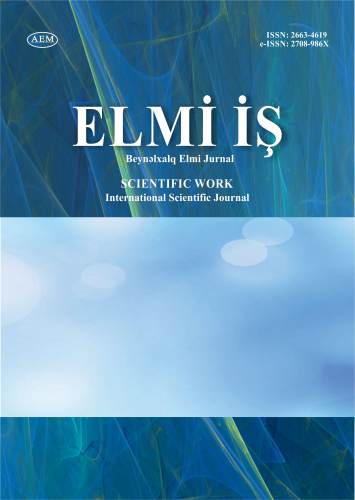DOI: https://doi.org/10.36719/2663-4619/86/26-34
Zəhra Abas qızı Allahverdiyeva
AMEA Nizami Gəncəvi adına Ədəbiyyat İnstitutu
filologiya üzrə fəlsəfə doktoru
zahra.allahverdiyeva@mail.ru
https://orcid.org/0000-0002-8697-0395
NİZAMİ GƏNCƏVİNİN DAVAMÇISI XACU KİRMANİ VƏ ONUN “KAMALNAMƏ” POEMASI
Xülasə
Şərq ədəbiyyatında epik şeirin inkişafı, o cümlədən Nizami Gəncəvinin “Xəmsə” mövzularının təsir dairəsinin öyrənilməsi ədəbiyyatşünaslığın aktual problemlərindən biri olaraq qalmaqdadır. Problemin nəzəri aspektləri XX əsr elminin əsas sahələrindən biri olaraq daim diqqət mərkəzində olmuşdur. A.Y.Krımski, Y.E.Bertels, V.M.Jirmunski, F.Köprülü, A.Sirri Ləvənd, H.Araslı, M.Mübariz, Q.Əliyev, R.Əliyev, R.Azadə, Q.Beqdeli, Xəlil Yusifli, N.Araslı, İ.Həmidov, T.Kərimli, M.Kazımov, A.B. Kudelin, A.V.Mixaylov, M.Y.Borev və başqaları bu sahədə əhəmiyyətli elmi-nəzəri fikirlər yürütmüşlər.
Təqdim olunan məqalədə Nizami ədəbi məktəbinin davamçısı, XIV əsrin məşhur filosof-şairi Xacu Kirmaninin “Xəmsə” yaradıcılığından “Kamalnamə” məsnəvisi tədqiqata cəlb olunur. Araşdırmalar göstərir ki, Xacu Kirmaninin “Xəmsə”si Azərbaycan poeziya məktəbinin dahi nümayəndəsi Nizami Gəncəvinin humanist ideyalarının və bədii üslub xüsusiyyətlərinin yeni-orta əsrlər dövrünə uyğun olaraq modern tərzdə davamıdır.
Poema 12 babdan (fəsildən) ibarətdir. Hər bir fəsildə islami-sufi fəlsəfənin tarixi və mahiyyəti haqqında şərhlər, dövrünün ictimai-əxlaqi görüşlərini əks etdirən fəlsəfi-didaktik məzmunlu hekayələr verilmişdir.
Əsər minacat, nət, şairin mürşidi Əbu İshaq Kaziruninin mədhi, seyri-süluk, salikin kamil nəfsə yetişməsi, aləmin şərhi, salikin 4 ünsürlə − su, torpaq, yel və odla mükaliməsi, odla mükalimədə can aləminə işarə etməsi, seyri-sülukla səfər etmə, mütənahi (sonu olan) dünyadan namü-tənahi (sonu olmayan) dünyaya keçid, ovçu könüllərin bəyanı, susmağın fəziləti və onun xüsusiyyətləri, Aristatalisin hekayəsi, dövranın vəfasızlığı haqqında, Əmir əl-möminin İmam Əlinin mübariz aşiqlə döyüşü, cavan qazi və Rum qeysərinin qızının hekayəsi, Həsən Bəsri haqqında hekayə, İbrahim Ədhəm haqqında, Sultan Mahmud Qəznəvi və Hindistan padşahının oğlunun hekayəsi, İmam Qəzali və qardaşının hekayəsi, daim Xızrı arzulayan padşah haqqında hekayə, sözün ilkinliyi, yəni Allaha bağlı olması və mənaya həsr olunmuş xüsusi başlıqlar və başqa maraqlı məzmunlu hissələr Xacu Kirmaninin zəngin ideya-fəlsəfi görüşlərini və sənətkarlıq qüdrətini əks etdirir. Əsərin sonunda şairin Cəmaləddin Əbu İshaq İncuya sitayişi, oğlu Mücirəddin Əbu Səid Əliyə nəsihəti və kitabın xətm olunması haqqında bölmələr Xacu Kirmani sənətinin mükəmməl bədii-fəlsəfi xüsusiyyətlərini nümayiş etdirir.
Məqalədə Xacu Kirmani “Xəmsə”sinin indiyədək tam tədqiq olunmayan halqası − “Kamalnamə” adlı fəlsəfi məzmunlu didaktik əsəri tədqiqata cəlb olunur; burada tarixi-fəlsəfi məsələlər və şairin poetik axtarışları nəzərdən keçirilir.
Açar sözlər: Nizami Gəncəvi, Xacu Kirmani, Xəmsə, “Kamalnamə”, cavab, didaktik üslub
Zahra Abas Allahverdiyeva
Institute of Literature named after Nizami Ganjavi of ANAS
Ph.D in Philology
zahra.allahverdiyeva@mail.ru
https://orcid.org/0000-0002-8697-0395
Khaju Kirmani the successor of Nizami Ganjavi and his poem "Kamalname"
Abstract
The study of the interactions and connections between the cultures and literatures of the peoples of the Near and Middle East is an important problem that is always in the focus of world and Azerbaijani literary criticism. In the twentieth century, the theoretical aspects of the problem have been identified, and considerable research has been conducted in various areas on the basis of the historical-comparative method.
In the past, A.Y.Krymsky, Y.E.Bertels, V.M.Jirmunski, F.Koprulu, A.Sirri Lavand, H.Arasli, M.Mubariz, G.Aliyev, R.Aliyev, R.Azade, H.Yusifli, N.Arasli, I.Hamidov, T.Kerimli, M.Kazimov, A.B.Kudelin, A.V.Mikhailov, M.Y.Borev and others made important scientific and theoretical ideas in this field.
The study of numerous works in Eastern literature under the influence of Nizami Ganjavi's "Khamsa" themes on the basis of the above-mentioned principles remains one of the urgent problems of literary criticism.
In the presented article, the prose "Kamalname" from the works of "Khamsa" by the famous philosopher-poet of the XIV century Khaju Kirmani, the successor of Nizami literary school, is involved in research. Research shows that Khaju Kirmani's "Khamsa" is a modern continuation of the humanist ideas and artistic style features of the great representative of the Azerbaijani school of poetry Nizami Ganjavi in accordance with the new-medieval period.
The poem consists of 12 chapters. Each chapter contains comments on the history and essence of Islamic-Sufi philosophy, and philosophical-didactic stories reflecting the socio-moral views of the time.
The work praises, praises, praises the poet's mentor Abu Ishaq Kaziruni, seyri-suluk, Salik's perfect maturity, interpretation of the world, salik's dialogue with the 4 elements − water, earth, wind and fire, pointing to the world of soul in dialogue with fire, seyru-suluk The transition from the world of the unseen to the world of the unseen, the declaration of the hunter's heart, the virtue of silence and its characteristics, the story of Aristatalis, the infidelity of the times, the battle of Amir al-Mu'minin with Imam Ali, the story of the young judge , The story of Hasan Basri, the story of Ibrahim Adham, the story of Sultan Mahmud Ghaznavi and the son of the king of India, the story of Imam Ghazali and his brother, the story of the king who always dreamed of Khidr, the originality of the word It reflects the rich ideological and philosophical views of Khaju Kirmani and the power of art. At the end of the work, the sections on the poet's worship of Jamaladdin Abu Ishaq Inju, his son Mujiraddin Abu Said Ali's advice and the completion of the book demonstrate the perfect artistic and philosophical features of Khaju Kirmani's art.
Keywords: Nizami Ganjavi, Khaju Kirmani, Khamsa, the answer, “Kamalname”, didactic style

